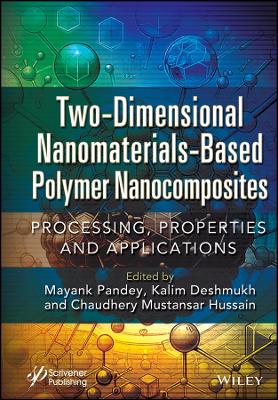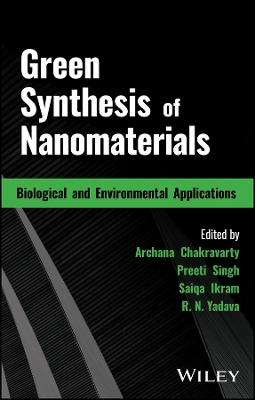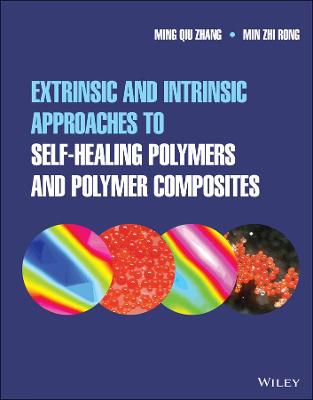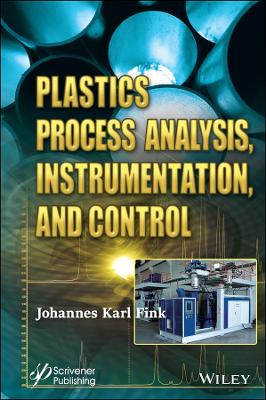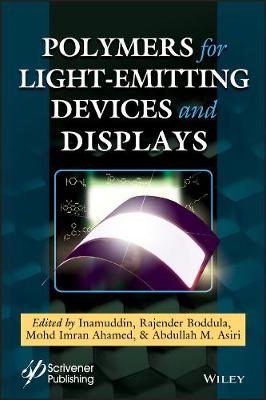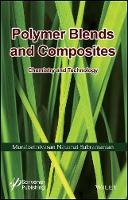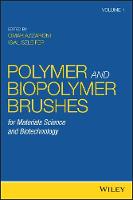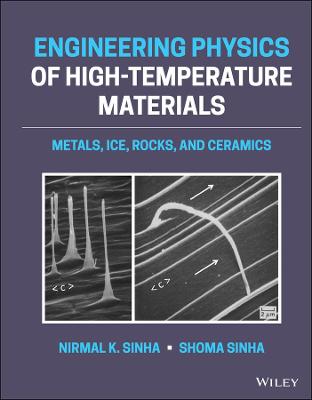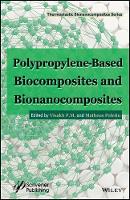Polymer Morphology
 -15%
portes grátis
-15%
portes grátis
Polymer Morphology
Principles, Characterization, and Processing
Guo, Qipeng
John Wiley & Sons Inc
06/2016
464
Dura
Inglês
9781118452158
15 a 20 dias
1284
LIST OF CONTRIBUTORS xv
PART I PRINCIPLES AND METHODS OF CHARACTERIZATION 1
1 Overview and Prospects of Polymer Morphology 3
Jerold M. Schultz
1.1 Introductory Remarks 3
1.2 Experimental Avenues of Morphological Research 4
1.2.1 Morphological Characterization: The Enabling of in situ Measurements 4
1.2.2 Morphology-Property Investigation 5
1.2.3 Morphology Development 7
1.3 Modeling and Simulation 8
1.3.1 Self-Generated Fields 9
1.4 Wishful Thinking 11
1.5 Summary 11
References 12
2 X-ray Diffraction from Polymers 14
N. Sanjeeva Murthy
2.1 Introduction 14
2.2 Basic Principles 14
2.3 Instrumentation 16
2.4 Structure Determination 17
2.4.1 Lattice Dimensions 17
2.4.2 Molecular Modeling 18
2.4.3 Rietveld Method 18
2.4.4 Pair Distribution Functions 18
2.5 Phase Analysis 19
2.5.1 Crystallinity Determination 20
2.5.2 Composition Analysis 21
2.6 Crystallite Size and Disorder 21
2.7 Orientation Analysis 22
2.7.1 Crystalline Orientation 22
2.7.2 Uniaxial Orientation 22
2.7.3 Biaxial Orientation 24
2.7.4 Amorphous Orientation 25
2.8 Small-Angle Scattering 25
2.8.1 Central Diffuse Scattering 26
2.8.2 Discrete Reflections from Lamellar Structures 27
2.8.3 Small-Angle Neutron Scattering and Solvent Diffusion 29
2.9 Specialized Measurements 30
2.9.1 In situ Experiments 30
2.9.2 Microbeam Diffraction 31
2.9.3 Grazing Incidence Diffraction 32
2.10 Summary 33
References 33
3 Electron Microscopy of Polymers 37
Goerg H. Michler and Werner Lebek
3.1 Introduction 37
3.2 Microscopic Techniques 37
3.2.1 Scanning Electron Microscopy (SEM) 37
3.2.2 Transmission Electron Microscopy (TEM) 42
3.2.3 Comparison of Different Microscopic Techniques 45
3.2.4 Image Processing and Image Analysis 46
3.3 Sample Preparation 47
3.4 In situ Microscopy 50
References 52
4 Characterization of Polymer Morphology by Scattering Techniques 54
Jean-Michel Guenet
4.1 Introduction 54
4.2 A Short Theoretical Presentation 55
4.2.1 General Expressions 55
4.2.2 The Form Factor 56
4.3 Experimental Aspects 60
4.3.1 The Contrast Factor 60
4.3.2 Experimental Setup 61
4.4 Typical Results 62
4.4.1 Neutrons Experiments: A Contrast Variation Story 62
4.4.2 X-Ray Experiments: A Time-Resolved Story 67
4.5 Concluding Remarks 69
References 69
5 Differential Scanning Calorimetry of Polymers 72
Alejandro J. Mueller and Rose Mary Michell
5.1 Introduction to Differential Scanning Calorimetry. Basic Principles and Types of DSC Equipment 72
5.2 Detection of First-Order and Second-Order Transitions by DSC. Applications of Standard DSC Experiments to the Determination of the Glass Transition Temperature and the Melting Temperature of Polymeric Materials 74
5.3 Self-Nucleation 75
5.3.1 Quantification of the Nucleation Efficiency 77
5.4 Thermal Fractionation 78
5.5 Multiphasic Materials: Polymer Blends and Block Copolymers. Fractionated Crystallization and Confinement Effects 81
5.5.1 Blends and Fractionated Crystallization 81
5.5.2 Copolymers 85
5.5.3 Copolymers Versus Blends 87
5.5.4 The Crystallization of Polymers and Copolymers within Nanoporous Templates 88
5.6 Self-Nucleation and the Efficiency Scale to Evaluate Nucleation Power 91
5.6.1 Supernucleation 93
5.7 Determination of Overall Isothermal Crystallization by DSC 95
5.8 Conclusions 95
Acknowledgment 95
References 95
6 Imaging Polymer Morphology using Atomic Force Microscopy 100
Holger Schoenherr
6.1 Introduction 100
6.2 Fundamental AFM Techniques 101
6.2.1 Contact Mode AFM 101
6.2.2 Intermittent Contact (Tapping) Mode AFM 104
6.2.3 Further Dynamic AFM Modes 105
6.3 Imaging of Polymer Morphology 107
6.3.1 Single Polymer Chains 107
6.3.2 Crystal Structures 107
6.3.3 Lamellar Crystals 109
6.3.4 Spherulites 109
6.3.5 Multiphase Systems 109
6.3.6 Polymeric Nanostructures 111
6.4 Property Mapping 113
6.4.1 Nanomechanical Properties 113
6.4.2 Scanning Thermal Microscopy 115
References 115
7 FTIR Imaging of Polymeric Materials 118
S. G. Kazarian and K. L. A. Chan
7.1 Introduction 118
7.2 Principles of FTIR Imaging 118
7.3 Sampling Methods 120
7.3.1 Transmission Mode 120
7.3.2 Attenuated Total Reflection (ATR) Mode 121
7.4 Spatial Resolution 122
7.4.1 Transmission FTIR Imaging 123
7.4.2 ATR-FTIR Spectroscopic Imaging 123
7.5 Recent Applications 124
7.5.1 Polymer Blends 124
7.5.2 Polymer Processes 125
7.5.3 Polarized FTIR Imaging for Orientation Studies 126
7.6 Conclusions 127
References 128
8 NMR Analysis of Morphology and Structure of Polymers 131
Takeshi Yamanobe and Hiroki Uehara
8.1 Introduction 131
8.2 Basic Concepts in NMR 131
8.2.1 Principles of NMR 131
8.2.2 Analysis of the Free Induction Decay (FID) 132
8.3 Morphology and Relaxation Behavior of Polyethylene 134
8.3.1 Morphology and Molecular Mobility 134
8.3.2 Lamellar Thickening by Annealing 134
8.3.3 Entanglement in the Amorphous Phase 136
8.4 Morphology and Structure of the Nascent Powders 137
8.4.1 Etching by Fuming Nitric Acid 137
8.4.2 Structural Change by Annealing 138
8.4.3 Nascent Isotactic Polypropylene Powder 139
8.5 Kinetics of Dynamic Process of Polymers 141
8.5.1 Melt Drawing of Polyethylene 141
8.5.2 Crystallization Mechanism of Nylon 46 143
8.5.3 Degree of Curing of Novolac Resins 145
8.6 Conclusions 146
References 146
PART II MORPHOLOGY PROPERTIES AND PROCESSING 151
9 Small-Angle X-ray Scattering for Morphological Analysis of Semicrystalline Polymers 153
Anne Seidlitz and Thomas Thurn-Albrecht
9.1 Introduction 153
9.2 Small-angle X-ray Scattering 153
9.2.1 Typical Experimental Setup 153
9.2.2 Basic Formalism Describing the Relation between Real-Space Structure and Scattering Intensity in a SAXS Experiment 154
9.2.3 Methods of Analysis Used for SAXS on Semicrystalline Polymers 155
9.3 Concluding Remarks 162
Appendix: Calculation of the Model Function K? '' sim(s) 163
References 163
10 Crystalline Morphology of Homopolymers and Block Copolymers 165
Shuichi Nojima and Hironori Marubayashi
10.1 Introduction 165
10.2 Crystalline Morphology of Homopolymers 165
10.2.1 Crystal Structure 165
10.2.2 Lamellar Morphology 167
10.2.3 Spherulite Structure 168
10.2.4 Crystalline Morphology of Homopolymers Confined in Isolated Nanodomains 168
10.2.5 Crystalline Morphology of Polymer Blends 169
10.3 Crystalline Morphology of Block Copolymers 171
10.3.1 Crystalline Morphology of Weakly Segregated Block Copolymers 172
10.3.2 Crystalline Morphology of Block Copolymers with Glassy Amorphous Blocks 173
10.3.3 Crystalline Morphology of Strongly Segregated Block Copolymers 174
10.3.4 Crystalline Morphology of Double Crystalline Block Copolymers 175
10.4 Concluding Remarks 176
References 176
11 Isothermal Crystallization Kinetics of Polymers 181
Alejandro J. Mueller Rose Mary Michell and Arnaldo T. Lorenzo
11.1 Introduction 181
11.2 Crystallization Process 182
11.3 Crystallization Kinetics 182
11.3.1 The Avrami Equation [31] 183
11.3.2 Nucleation and Crystal Growth: Lauritzen-Hofmann Theory 188
11.4 Isothermal Crystallization Kinetics-Morphology Relationship 191
11.4.1 Linear PS-b-PCL versus Miktoarm (PS2)-b-(PCL2) Block Copolymers 191
11.4.2 Crystallization Kinetics and Morphology of PLLA-b-PCL Diblock Copolymers 194
11.4.3 Nucleation and Crystallization Kinetics of Double Crystalline Polyethylene/Polyamide (PE/PA) Blends 196
11.4.4 Crystallization Kinetics of Poly(??-Caprolactone)/Carbon Nanotubes (PCL/CNTs) Blends 200
11.5 Conclusions 201
Acknowledgments 201
References 201
12 Surface-induced Polymer Crystallization 204
Xiaoli Sun and Shouke Yan
12.1 Introduction 204
12.2 Influence of Foreign Surface on the Crystallization Kinetics of Polymers 205
12.3 Influence of Foreign Surface on the Crystal Structure and Morphology of Polymers 205
12.3.1 Crystallization of Thin Polymer Films on Amorphous Foreign Surface 205
12.3.2 Crystallization of Polymer Thin Films on Crystalline Foreign Surface with Special Crystallographic Interaction 209
12.4 Bulk Crystallization of Polymers in Contact with a Foreign Surface 226
12.5 Summary 234
References 235
13 Thermodynamics and Kinetics of Polymer Crystallization 242
Wenbing Hu and Liyun Zha
13.1 Introduction 242
13.2 Thermodynamics of Polymer Crystallization 242
13.3 Crystal Nucleation 247
13.4 Crystal Growth 251
13.5 Crystal Annealing 254
13.6 Summary 255
References 256
14 Self-Assembly and Morphology in Block Copolymer Systems with Specific Interactions 259
Anbazhagan Palanisamy and Qipeng Guo
14.1 Introduction 259
14.2 Block Copolymer Systems with Hydrogen Bonding Interaction in Solid State 260
14.2.1 Diblock Copolymer/Homopolymer Systems 260
14.2.2 Diblock/Triblock Copolymer Systems 264
14.3 Block Copolymer Systems with Hydrogen-Bonding Interaction in Solution 268
14.3.1 Single-Component Block Copolymer Systems 268
14.3.2 Diblock Copolymer/Homopolymer Systems 269
14.3.3 Diblock/Diblock Copolymer Systems 271
14.3.4 Triblock Copolymer Systems 275
14.4 Block Copolymer Systems with Ionic Interaction 275
14.4.1 Diblock Copolymer/Homopolymer Systems 275
14.4.2 Diblock/Triblock Copolymer Systems 276
14.5 Block Copolymer Blends via Metal-Ligand Coordination Bonds 278
14.6 Concluding Remarks 278
References 279
15 Dynamics Simulations of Microphase Separation in Block Copolymers 283
Xuehao He Xuejin Li Peng Chen and Haojun Liang
15.1 Introduction 283
15.2 Polymer Model and Simulation Algorithm 284
15.2.1 Monte Carlo Method 284
15.2.2 Dissipative Particle Dynamics Method 285
15.2.3 Polymeric Self-Consistent Field Theory 286
15.3 Dynamics of Self-Assembly of Block Copolymers 287
15.3.1 Phase Separation of Linear Block Copolymers 287
15.3.2 Self-Assembly of Star Block Copolymers in Melt 287
15.3.3 Self-Assembly of Block Copolymers in Constrained Systems 289
15.3.4 Micellization of Amphiphilic Block Copolymer in Solution 292
15.4 Outlook 294
References 295
16 Morphology Control of Polymer thin Films 299
Jiangang Liu Xinhong Yu Longjian Xue and Yanchun Han
16.1 Wetting 299
16.1.1 Dewetting Mechanisms 300
16.1.2 Dewetting Dynamics 301
16.1.3 Rim Instability 303
16.1.4 Factors Affecting the Stability of Polymer Thin Films 303
16.2 Thin Film of Polymer Blend 304
16.2.1 Fundamentals of Polymer Blends 305
16.2.2 Phase Separation in Thin Polymer Films 306
16.3 The Introduction of Polymer Blend Film in Solar Cells 307
16.3.1 Establish Interpenetrating Network Structure by Controlling Phase Separation 308
16.3.2 Control the Domain Size and Purify of the Domains 310
16.3.3 Adjust the Diffused Structure at the Interface Between Donor and Acceptor 312
16.3.4 Construct the Relationship Between Film Morphology and Device Performance 312
16.4 Summary and Outlook 313
References 313
17 Polymer Surface Topography and Nanomechanical Mapping 317
Hao Liu So Fujinami Dong Wang Ken Nakajima and Toshio Nishi
17.1 Introduction 317
17.2 Contact Mechanics 317
17.2.1 Hertzian Theory (Repulsion between Elastic Bodies) 318
17.2.2 Bradley Model (Interaction between Rigid Bodies) 318
17.2.3 Johnson-Kendall-Roberts (JKR) Model 318
17.2.4 Derjaguin-Muller-Toporov (DMT) Model 319
17.2.5 The JKR-DMT transition and Maugis-Dugdale (MD) Model 319
17.2.6 Adhesion Map 320
17.3 Application of Contact Mechanics to Experimental Data 321
17.3.1 Consideration of Contact Models 321
17.3.2 Force-Distance Curve Conversion 321
17.3.3 Analysis of Load-Indentation Curves 322
17.3.4 Nanomechanical Mapping 322
17.4 Application Examples 323
17.4.1 Effect of Processing Conditions on Morphology and Mechanical Properties of Block Copolymers 323
17.4.2 Measuring the Deformation of Both Ductile and Fragile Polymers 325
17.4.3 Nanorheological AFM on Rubbers 328
17.5 Conclusion 331
References 331
18 Polymer Morphology and Deformation Behavior 335
Masanori Hara
18.1 Introduction 335
18.2 Deformation Behavior of Amorphous Polymers 336
18.2.1 Deformation Behavior of Thin Films 336
18.2.2 Deformation Behavior of Bulk Polymers 338
18.3 Deformation Behavior of Semicrystalline Polymers 339
18.3.1 Deformation of Unoriented Semicrystalline Polymers 341
18.3.2 Strain Hardening and Network Density 341
18.4 Deformation Behavior of Block Copolymers 342
18.4.1 Block Copolymers Based on S and B 343
18.4.2 Block Copolymers Based on E and C (CHE) 345
18.5 Conclusions and Outlook 345
References 346
19 Morphology Development in Immiscible Polymer Blends 348
Ruth Cardinaels and Paula Moldenaers
19.1 Introduction 348
19.2 Morphology Development in Bulk Flow 350
19.2.1 Droplet-Matrix Structures 350
19.2.2 Fibrillar Structures 359
19.2.3 Cocontinuous Structures 361
19.3 Recent Advances in Polymer Blends 363
19.3.1 Immiscible Blends in Confined Flow 363
19.3.2 Blend Compatibilization by Nanoparticles 364
19.4 Conclusions 367
Acknowledgments 368
References 368
20 Processing Structure and Morphology in Polymer Nanocomposites 374
Duraccio Donatella Clara Silvestre Sossio Cimmino Antonella Marra and Marilena Pezzuto
20.1 Overview 374
20.2 Nanoparticles with One Dimension Less Than 100 nm (Layered Silicates) 375
20.3 Nanoparticles with Two Dimensions Less Than 100 nm (Carbon Nanotubes) 377
20.4 Nanoparticles with Three Dimensions Less Than 100 nm (Metal Metal Oxide) 380
20.5 Preparative Methods 382
20.5.1 Solution Processing 382
20.5.2 In situ Polymerization 383
20.5.3 Melt Processing 384
20.5.4 In situ Sol-Gel Technology 384
20.6 Structure and Morphology of Polymer Nanocomposites 385
20.7 Concluding Remarks 388
References 388
21 Morphology and Gas Barrier Properties of Polymer Nanocomposites 397
Abbas Ghanbari Marie-Claude Heuzey Pierre J. Carreau and Minh-Tan Ton-That
21.1 Introduction 397
21.2 Structure of Layered Silicates 397
21.3 Morphologies of Polymer-Layered Silicate Composites 398
21.4 Nanocomposite Preparation Methods 398
21.5 Challenges of Thermal Degradation in Melt Intercalation 400
21.6 Methods for Improving Gas Barrier Properties of Polymers 403
21.7 Polyamide Nanocomposites 405
21.8 Polyolefin Nanocomposites 405
21.9 Pet Nanocomposites 406
21.10 Polylactide Nanocomposites 413
21.11 Conclusions and Perspectives 414
References 415
22 Features on the Development and Stability of Phase Morphology in Complex Multicomponent Polymeric Systems: Main Focus on Processing Aspects 418
Charef Harrats Maria-Beatrice Coltelli and Gabriel Groeninckx
22.1 Introduction 418
22.2 Phase Morphology Development in Polymer Blends 419
22.2.1 Droplet-in-Matrix (Dispersed) Phase Morphology 419
22.2.2 Co-continuous Phase Morphology 419
22.2.3 Phase Morphology in Ternary Blends 420
22.3 Melt Processing of Polymer Blends 423
22.3.1 Morphology Buildup during Processing 423
22.3.2 Effects of Processing Parameters on Phase Morphology 424
22.4 Chemistry Involved in Polymer Blends 426
22.4.1 Effect of the Compatibilizer on Phase Morphology 426
22.4.2 Formation in situ of the Compatibilizer 427
22.4.3 Case of Reactive Ternary Blends 429
22.4.4 Stability of Phase Morphology in Reactively Compatibilized Blends 431
22.4.5 Organoclay-Promoted Phase Morphology 433
22.4.6 Conclusions 435
References 436
INDEX 439
LIST OF CONTRIBUTORS xv
PART I PRINCIPLES AND METHODS OF CHARACTERIZATION 1
1 Overview and Prospects of Polymer Morphology 3
Jerold M. Schultz
1.1 Introductory Remarks 3
1.2 Experimental Avenues of Morphological Research 4
1.2.1 Morphological Characterization: The Enabling of in situ Measurements 4
1.2.2 Morphology-Property Investigation 5
1.2.3 Morphology Development 7
1.3 Modeling and Simulation 8
1.3.1 Self-Generated Fields 9
1.4 Wishful Thinking 11
1.5 Summary 11
References 12
2 X-ray Diffraction from Polymers 14
N. Sanjeeva Murthy
2.1 Introduction 14
2.2 Basic Principles 14
2.3 Instrumentation 16
2.4 Structure Determination 17
2.4.1 Lattice Dimensions 17
2.4.2 Molecular Modeling 18
2.4.3 Rietveld Method 18
2.4.4 Pair Distribution Functions 18
2.5 Phase Analysis 19
2.5.1 Crystallinity Determination 20
2.5.2 Composition Analysis 21
2.6 Crystallite Size and Disorder 21
2.7 Orientation Analysis 22
2.7.1 Crystalline Orientation 22
2.7.2 Uniaxial Orientation 22
2.7.3 Biaxial Orientation 24
2.7.4 Amorphous Orientation 25
2.8 Small-Angle Scattering 25
2.8.1 Central Diffuse Scattering 26
2.8.2 Discrete Reflections from Lamellar Structures 27
2.8.3 Small-Angle Neutron Scattering and Solvent Diffusion 29
2.9 Specialized Measurements 30
2.9.1 In situ Experiments 30
2.9.2 Microbeam Diffraction 31
2.9.3 Grazing Incidence Diffraction 32
2.10 Summary 33
References 33
3 Electron Microscopy of Polymers 37
Goerg H. Michler and Werner Lebek
3.1 Introduction 37
3.2 Microscopic Techniques 37
3.2.1 Scanning Electron Microscopy (SEM) 37
3.2.2 Transmission Electron Microscopy (TEM) 42
3.2.3 Comparison of Different Microscopic Techniques 45
3.2.4 Image Processing and Image Analysis 46
3.3 Sample Preparation 47
3.4 In situ Microscopy 50
References 52
4 Characterization of Polymer Morphology by Scattering Techniques 54
Jean-Michel Guenet
4.1 Introduction 54
4.2 A Short Theoretical Presentation 55
4.2.1 General Expressions 55
4.2.2 The Form Factor 56
4.3 Experimental Aspects 60
4.3.1 The Contrast Factor 60
4.3.2 Experimental Setup 61
4.4 Typical Results 62
4.4.1 Neutrons Experiments: A Contrast Variation Story 62
4.4.2 X-Ray Experiments: A Time-Resolved Story 67
4.5 Concluding Remarks 69
References 69
5 Differential Scanning Calorimetry of Polymers 72
Alejandro J. Mueller and Rose Mary Michell
5.1 Introduction to Differential Scanning Calorimetry. Basic Principles and Types of DSC Equipment 72
5.2 Detection of First-Order and Second-Order Transitions by DSC. Applications of Standard DSC Experiments to the Determination of the Glass Transition Temperature and the Melting Temperature of Polymeric Materials 74
5.3 Self-Nucleation 75
5.3.1 Quantification of the Nucleation Efficiency 77
5.4 Thermal Fractionation 78
5.5 Multiphasic Materials: Polymer Blends and Block Copolymers. Fractionated Crystallization and Confinement Effects 81
5.5.1 Blends and Fractionated Crystallization 81
5.5.2 Copolymers 85
5.5.3 Copolymers Versus Blends 87
5.5.4 The Crystallization of Polymers and Copolymers within Nanoporous Templates 88
5.6 Self-Nucleation and the Efficiency Scale to Evaluate Nucleation Power 91
5.6.1 Supernucleation 93
5.7 Determination of Overall Isothermal Crystallization by DSC 95
5.8 Conclusions 95
Acknowledgment 95
References 95
6 Imaging Polymer Morphology using Atomic Force Microscopy 100
Holger Schoenherr
6.1 Introduction 100
6.2 Fundamental AFM Techniques 101
6.2.1 Contact Mode AFM 101
6.2.2 Intermittent Contact (Tapping) Mode AFM 104
6.2.3 Further Dynamic AFM Modes 105
6.3 Imaging of Polymer Morphology 107
6.3.1 Single Polymer Chains 107
6.3.2 Crystal Structures 107
6.3.3 Lamellar Crystals 109
6.3.4 Spherulites 109
6.3.5 Multiphase Systems 109
6.3.6 Polymeric Nanostructures 111
6.4 Property Mapping 113
6.4.1 Nanomechanical Properties 113
6.4.2 Scanning Thermal Microscopy 115
References 115
7 FTIR Imaging of Polymeric Materials 118
S. G. Kazarian and K. L. A. Chan
7.1 Introduction 118
7.2 Principles of FTIR Imaging 118
7.3 Sampling Methods 120
7.3.1 Transmission Mode 120
7.3.2 Attenuated Total Reflection (ATR) Mode 121
7.4 Spatial Resolution 122
7.4.1 Transmission FTIR Imaging 123
7.4.2 ATR-FTIR Spectroscopic Imaging 123
7.5 Recent Applications 124
7.5.1 Polymer Blends 124
7.5.2 Polymer Processes 125
7.5.3 Polarized FTIR Imaging for Orientation Studies 126
7.6 Conclusions 127
References 128
8 NMR Analysis of Morphology and Structure of Polymers 131
Takeshi Yamanobe and Hiroki Uehara
8.1 Introduction 131
8.2 Basic Concepts in NMR 131
8.2.1 Principles of NMR 131
8.2.2 Analysis of the Free Induction Decay (FID) 132
8.3 Morphology and Relaxation Behavior of Polyethylene 134
8.3.1 Morphology and Molecular Mobility 134
8.3.2 Lamellar Thickening by Annealing 134
8.3.3 Entanglement in the Amorphous Phase 136
8.4 Morphology and Structure of the Nascent Powders 137
8.4.1 Etching by Fuming Nitric Acid 137
8.4.2 Structural Change by Annealing 138
8.4.3 Nascent Isotactic Polypropylene Powder 139
8.5 Kinetics of Dynamic Process of Polymers 141
8.5.1 Melt Drawing of Polyethylene 141
8.5.2 Crystallization Mechanism of Nylon 46 143
8.5.3 Degree of Curing of Novolac Resins 145
8.6 Conclusions 146
References 146
PART II MORPHOLOGY PROPERTIES AND PROCESSING 151
9 Small-Angle X-ray Scattering for Morphological Analysis of Semicrystalline Polymers 153
Anne Seidlitz and Thomas Thurn-Albrecht
9.1 Introduction 153
9.2 Small-angle X-ray Scattering 153
9.2.1 Typical Experimental Setup 153
9.2.2 Basic Formalism Describing the Relation between Real-Space Structure and Scattering Intensity in a SAXS Experiment 154
9.2.3 Methods of Analysis Used for SAXS on Semicrystalline Polymers 155
9.3 Concluding Remarks 162
Appendix: Calculation of the Model Function K? '' sim(s) 163
References 163
10 Crystalline Morphology of Homopolymers and Block Copolymers 165
Shuichi Nojima and Hironori Marubayashi
10.1 Introduction 165
10.2 Crystalline Morphology of Homopolymers 165
10.2.1 Crystal Structure 165
10.2.2 Lamellar Morphology 167
10.2.3 Spherulite Structure 168
10.2.4 Crystalline Morphology of Homopolymers Confined in Isolated Nanodomains 168
10.2.5 Crystalline Morphology of Polymer Blends 169
10.3 Crystalline Morphology of Block Copolymers 171
10.3.1 Crystalline Morphology of Weakly Segregated Block Copolymers 172
10.3.2 Crystalline Morphology of Block Copolymers with Glassy Amorphous Blocks 173
10.3.3 Crystalline Morphology of Strongly Segregated Block Copolymers 174
10.3.4 Crystalline Morphology of Double Crystalline Block Copolymers 175
10.4 Concluding Remarks 176
References 176
11 Isothermal Crystallization Kinetics of Polymers 181
Alejandro J. Mueller Rose Mary Michell and Arnaldo T. Lorenzo
11.1 Introduction 181
11.2 Crystallization Process 182
11.3 Crystallization Kinetics 182
11.3.1 The Avrami Equation [31] 183
11.3.2 Nucleation and Crystal Growth: Lauritzen-Hofmann Theory 188
11.4 Isothermal Crystallization Kinetics-Morphology Relationship 191
11.4.1 Linear PS-b-PCL versus Miktoarm (PS2)-b-(PCL2) Block Copolymers 191
11.4.2 Crystallization Kinetics and Morphology of PLLA-b-PCL Diblock Copolymers 194
11.4.3 Nucleation and Crystallization Kinetics of Double Crystalline Polyethylene/Polyamide (PE/PA) Blends 196
11.4.4 Crystallization Kinetics of Poly(??-Caprolactone)/Carbon Nanotubes (PCL/CNTs) Blends 200
11.5 Conclusions 201
Acknowledgments 201
References 201
12 Surface-induced Polymer Crystallization 204
Xiaoli Sun and Shouke Yan
12.1 Introduction 204
12.2 Influence of Foreign Surface on the Crystallization Kinetics of Polymers 205
12.3 Influence of Foreign Surface on the Crystal Structure and Morphology of Polymers 205
12.3.1 Crystallization of Thin Polymer Films on Amorphous Foreign Surface 205
12.3.2 Crystallization of Polymer Thin Films on Crystalline Foreign Surface with Special Crystallographic Interaction 209
12.4 Bulk Crystallization of Polymers in Contact with a Foreign Surface 226
12.5 Summary 234
References 235
13 Thermodynamics and Kinetics of Polymer Crystallization 242
Wenbing Hu and Liyun Zha
13.1 Introduction 242
13.2 Thermodynamics of Polymer Crystallization 242
13.3 Crystal Nucleation 247
13.4 Crystal Growth 251
13.5 Crystal Annealing 254
13.6 Summary 255
References 256
14 Self-Assembly and Morphology in Block Copolymer Systems with Specific Interactions 259
Anbazhagan Palanisamy and Qipeng Guo
14.1 Introduction 259
14.2 Block Copolymer Systems with Hydrogen Bonding Interaction in Solid State 260
14.2.1 Diblock Copolymer/Homopolymer Systems 260
14.2.2 Diblock/Triblock Copolymer Systems 264
14.3 Block Copolymer Systems with Hydrogen-Bonding Interaction in Solution 268
14.3.1 Single-Component Block Copolymer Systems 268
14.3.2 Diblock Copolymer/Homopolymer Systems 269
14.3.3 Diblock/Diblock Copolymer Systems 271
14.3.4 Triblock Copolymer Systems 275
14.4 Block Copolymer Systems with Ionic Interaction 275
14.4.1 Diblock Copolymer/Homopolymer Systems 275
14.4.2 Diblock/Triblock Copolymer Systems 276
14.5 Block Copolymer Blends via Metal-Ligand Coordination Bonds 278
14.6 Concluding Remarks 278
References 279
15 Dynamics Simulations of Microphase Separation in Block Copolymers 283
Xuehao He Xuejin Li Peng Chen and Haojun Liang
15.1 Introduction 283
15.2 Polymer Model and Simulation Algorithm 284
15.2.1 Monte Carlo Method 284
15.2.2 Dissipative Particle Dynamics Method 285
15.2.3 Polymeric Self-Consistent Field Theory 286
15.3 Dynamics of Self-Assembly of Block Copolymers 287
15.3.1 Phase Separation of Linear Block Copolymers 287
15.3.2 Self-Assembly of Star Block Copolymers in Melt 287
15.3.3 Self-Assembly of Block Copolymers in Constrained Systems 289
15.3.4 Micellization of Amphiphilic Block Copolymer in Solution 292
15.4 Outlook 294
References 295
16 Morphology Control of Polymer thin Films 299
Jiangang Liu Xinhong Yu Longjian Xue and Yanchun Han
16.1 Wetting 299
16.1.1 Dewetting Mechanisms 300
16.1.2 Dewetting Dynamics 301
16.1.3 Rim Instability 303
16.1.4 Factors Affecting the Stability of Polymer Thin Films 303
16.2 Thin Film of Polymer Blend 304
16.2.1 Fundamentals of Polymer Blends 305
16.2.2 Phase Separation in Thin Polymer Films 306
16.3 The Introduction of Polymer Blend Film in Solar Cells 307
16.3.1 Establish Interpenetrating Network Structure by Controlling Phase Separation 308
16.3.2 Control the Domain Size and Purify of the Domains 310
16.3.3 Adjust the Diffused Structure at the Interface Between Donor and Acceptor 312
16.3.4 Construct the Relationship Between Film Morphology and Device Performance 312
16.4 Summary and Outlook 313
References 313
17 Polymer Surface Topography and Nanomechanical Mapping 317
Hao Liu So Fujinami Dong Wang Ken Nakajima and Toshio Nishi
17.1 Introduction 317
17.2 Contact Mechanics 317
17.2.1 Hertzian Theory (Repulsion between Elastic Bodies) 318
17.2.2 Bradley Model (Interaction between Rigid Bodies) 318
17.2.3 Johnson-Kendall-Roberts (JKR) Model 318
17.2.4 Derjaguin-Muller-Toporov (DMT) Model 319
17.2.5 The JKR-DMT transition and Maugis-Dugdale (MD) Model 319
17.2.6 Adhesion Map 320
17.3 Application of Contact Mechanics to Experimental Data 321
17.3.1 Consideration of Contact Models 321
17.3.2 Force-Distance Curve Conversion 321
17.3.3 Analysis of Load-Indentation Curves 322
17.3.4 Nanomechanical Mapping 322
17.4 Application Examples 323
17.4.1 Effect of Processing Conditions on Morphology and Mechanical Properties of Block Copolymers 323
17.4.2 Measuring the Deformation of Both Ductile and Fragile Polymers 325
17.4.3 Nanorheological AFM on Rubbers 328
17.5 Conclusion 331
References 331
18 Polymer Morphology and Deformation Behavior 335
Masanori Hara
18.1 Introduction 335
18.2 Deformation Behavior of Amorphous Polymers 336
18.2.1 Deformation Behavior of Thin Films 336
18.2.2 Deformation Behavior of Bulk Polymers 338
18.3 Deformation Behavior of Semicrystalline Polymers 339
18.3.1 Deformation of Unoriented Semicrystalline Polymers 341
18.3.2 Strain Hardening and Network Density 341
18.4 Deformation Behavior of Block Copolymers 342
18.4.1 Block Copolymers Based on S and B 343
18.4.2 Block Copolymers Based on E and C (CHE) 345
18.5 Conclusions and Outlook 345
References 346
19 Morphology Development in Immiscible Polymer Blends 348
Ruth Cardinaels and Paula Moldenaers
19.1 Introduction 348
19.2 Morphology Development in Bulk Flow 350
19.2.1 Droplet-Matrix Structures 350
19.2.2 Fibrillar Structures 359
19.2.3 Cocontinuous Structures 361
19.3 Recent Advances in Polymer Blends 363
19.3.1 Immiscible Blends in Confined Flow 363
19.3.2 Blend Compatibilization by Nanoparticles 364
19.4 Conclusions 367
Acknowledgments 368
References 368
20 Processing Structure and Morphology in Polymer Nanocomposites 374
Duraccio Donatella Clara Silvestre Sossio Cimmino Antonella Marra and Marilena Pezzuto
20.1 Overview 374
20.2 Nanoparticles with One Dimension Less Than 100 nm (Layered Silicates) 375
20.3 Nanoparticles with Two Dimensions Less Than 100 nm (Carbon Nanotubes) 377
20.4 Nanoparticles with Three Dimensions Less Than 100 nm (Metal Metal Oxide) 380
20.5 Preparative Methods 382
20.5.1 Solution Processing 382
20.5.2 In situ Polymerization 383
20.5.3 Melt Processing 384
20.5.4 In situ Sol-Gel Technology 384
20.6 Structure and Morphology of Polymer Nanocomposites 385
20.7 Concluding Remarks 388
References 388
21 Morphology and Gas Barrier Properties of Polymer Nanocomposites 397
Abbas Ghanbari Marie-Claude Heuzey Pierre J. Carreau and Minh-Tan Ton-That
21.1 Introduction 397
21.2 Structure of Layered Silicates 397
21.3 Morphologies of Polymer-Layered Silicate Composites 398
21.4 Nanocomposite Preparation Methods 398
21.5 Challenges of Thermal Degradation in Melt Intercalation 400
21.6 Methods for Improving Gas Barrier Properties of Polymers 403
21.7 Polyamide Nanocomposites 405
21.8 Polyolefin Nanocomposites 405
21.9 Pet Nanocomposites 406
21.10 Polylactide Nanocomposites 413
21.11 Conclusions and Perspectives 414
References 415
22 Features on the Development and Stability of Phase Morphology in Complex Multicomponent Polymeric Systems: Main Focus on Processing Aspects 418
Charef Harrats Maria-Beatrice Coltelli and Gabriel Groeninckx
22.1 Introduction 418
22.2 Phase Morphology Development in Polymer Blends 419
22.2.1 Droplet-in-Matrix (Dispersed) Phase Morphology 419
22.2.2 Co-continuous Phase Morphology 419
22.2.3 Phase Morphology in Ternary Blends 420
22.3 Melt Processing of Polymer Blends 423
22.3.1 Morphology Buildup during Processing 423
22.3.2 Effects of Processing Parameters on Phase Morphology 424
22.4 Chemistry Involved in Polymer Blends 426
22.4.1 Effect of the Compatibilizer on Phase Morphology 426
22.4.2 Formation in situ of the Compatibilizer 427
22.4.3 Case of Reactive Ternary Blends 429
22.4.4 Stability of Phase Morphology in Reactively Compatibilized Blends 431
22.4.5 Organoclay-Promoted Phase Morphology 433
22.4.6 Conclusions 435
References 436
INDEX 439



